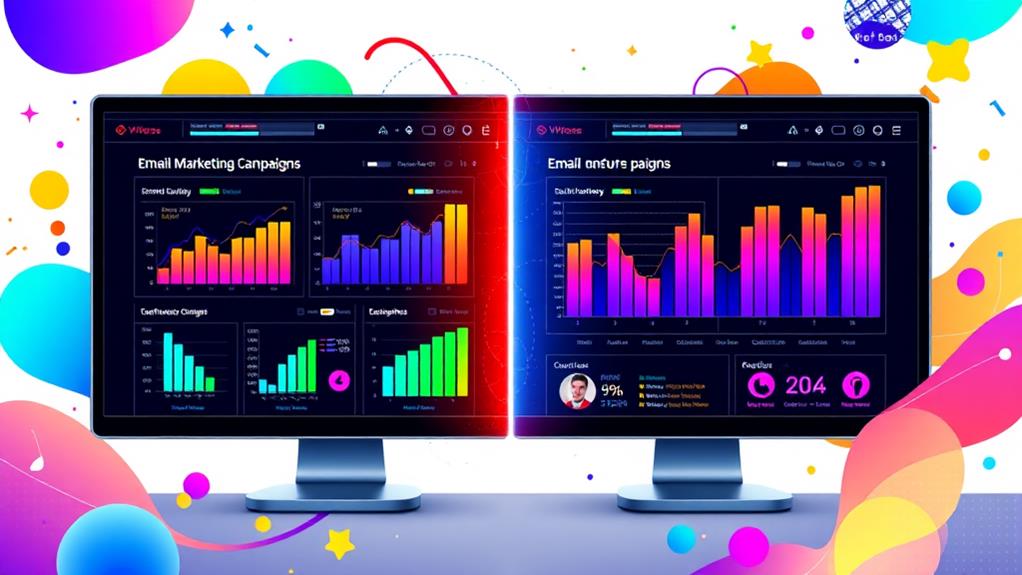Email automation markedly enhances efficiency and drives growth by automating repetitive tasks and personalizing communication. Key features such as workflow automation reduce manual efforts, reclaiming up to 20 hours weekly for strategic activities. Personalized messaging can achieve 29% higher open rates, while timely cart abandonment flows facilitate a 50% increase in sales. Strategic A/B testing boosts click-through rates by up to 37%, and audience segmentation guarantees engagement, increasing open rates up to 50%. Integration with CRM systems synchronizes data for timely communication. Explore these features to release the full potential of email marketing automation, furthering growth opportunities.
Key Takeaways
- Email automation boosts sales by 20% with personalized and timely messages.
- A/B testing enhances open and click-through rates for optimized campaign performance.
- Trigger-based strategies increase engagement by responding to specific user actions.
- Automated follow-ups nurture leads, improving customer retention and lifetime value.
- Audience segmentation improves engagement by up to 50% with targeted messaging.
Understanding Email Automation
Email automation represents a vital advancement in the domain of digital marketing, leveraging specialized software to automate the email dispatch process based on predefined triggers such as user behavior or scheduled timelines.
Understanding email automation basics involves recognizing its capacity to streamline communication, considerably saving time by automating repetitive tasks. This efficiency allows marketing teams to pivot their focus towards more strategic initiatives, enhancing overall productivity.
A common misconception about email automation is that it diminishes personalization. However, automation actually facilitates the delivery of personalized and timely emails, leading to higher engagement rates.
Data reveals that targeted messaging can boost open rates by up to 50%, underscoring the effectiveness of automated, customized content. Another misconception is that automation is solely about reducing workload. While it indeed frees up time, its strategic value lies in driving performance metrics, such as conversion rates. Companies have reported up to a 20% increase in sales, attributed to well-executed automation strategies.
Moreover, email automation basics emphasize the importance of data-driven insights. These insights enable marketers to refine their strategies continuously, ensuring that their campaigns are adaptive and optimized for better results.
Understanding these fundamentals is essential for leveraging email automation to its full potential.
Key Benefits of Automation
Email automation presents a compelling advantage by markedly enhancing both efficiency and engagement, as evidenced by its ability to reduce manual workloads and achieve 29% higher open rates through personalized messaging.
By optimizing strategic workflows, businesses can schedule campaigns in advance, ensuring timely communication and scalability without additional effort.
Ultimately, the implementation of automated strategies not only boosts productivity but also delivers a substantial return on investment, averaging 122%, underscoring its financial efficacy.
Efficiency and Engagement Boost
In today's competitive digital landscape, leveraging automated email marketing is essential for businesses aiming to enhance efficiency and engagement. By optimizing email frequency and monitoring engagement metrics, companies can greatly boost their marketing effectiveness. Automation facilitates a 50% sales increase through timely cart abandonment flows, highlighting the impact of strategic email delivery on revenue. Personalized content, a cornerstone of automated campaigns, can achieve open rates of up to 29%, showcasing the power of targeted engagement over generic approaches.
| Key Metric | Impact on Business |
|---|---|
| Cart Abandonment Sales Increase | 50% boost in sales |
| Personalized Email Open Rates | Up to 29% improvement |
| Time Saved for Strategic Tasks | Up to 20 hours per week |
| Customer Retention Increase | 300% enhancement |
Moreover, automation allows marketing teams to reclaim up to 20 hours weekly, shifting focus towards strategic initiatives rather than manual tasks. Implementing A/B testing within these automated campaigns can further enhance engagement, increasing click-through rates by up to 37%. Additionally, brands utilizing consistent automated sequences report a staggering 300% increase in customer retention, underscoring the importance of regular and relevant communication. By adopting these strategies, businesses can drive growth and maintain a competitive edge.
Strategic Workflow Optimization
Building on the efficiency and engagement enhancements brought by email automation, strategic workflow refinement emerges as a pivotal component in maximizing these benefits. By implementing workflow mapping, businesses can visualize the entire email marketing process, identifying bottlenecks and opportunities for improvement.
This systematic approach allows for process streamlining, reducing manual tasks and redundancies that can slow down marketing efforts. As a result, marketing teams are liberated to focus on more strategic initiatives, driving both efficiency and productivity.
The integration of predefined rules for email triggers and personalization further refines this process. By sending targeted messages at ideal times, businesses can achieve higher open and click-through rates.
This is complemented by A/B testing capabilities, which facilitate continuous enhancement of campaigns. By leveraging data-driven insights, companies can make informed adjustments that boost engagement and conversion rates.
Moreover, automated follow-up management offers an additional layer of strategic workflow refinement. By canceling remaining emails once a response is received, it guarantees timely interactions, thereby improving the customer experience.
Performance analytics from these campaigns provide a wealth of information on engagement metrics, enabling marketers to make informed decisions for future strategies, consequently enhancing overall campaign effectiveness.
Essential Automation Features
Incorporating ideal scheduling techniques and trigger-based email strategies is essential for maximizing the impact of email automation.
By leveraging predefined rules for email triggers, businesses can deliver personalized and timely content that enhances subscriber engagement and conversion rates.
Furthermore, strategic scheduling guarantees that emails reach recipients at the most opportune moments, consequently boosting open rates and overall campaign effectiveness.
Optimal Scheduling Techniques
Mastering the art of ideal scheduling in email automation is akin to orchestrating a symphony, where each note represents a precisely timed message delivered at the peak of audience engagement. Effective timing strategies are vital in tapping into subscribers' engagement patterns, greatly boosting open and click-through rates. By pre-scheduling campaigns based on subscriber behaviors and peak engagement times, marketers can guarantee their messages are not only seen but acted upon.
Utilizing A/B testing for send times empowers businesses to refine their timing strategies, discovering the best moments to reach their audience. This data-driven approach leads to enhanced campaign performance and more meaningful interactions.
Meanwhile, audience segmentation by time zones guarantees emails are delivered at the most convenient local times, maximizing engagement across diverse geographical regions.
Furthermore, drip campaigns offer a structured approach to guide subscribers through their customer journey with strategically scheduled emails. By nurturing leads over time, these campaigns increase conversion rates and customer retention.
Real-time reporting on email performance metrics allows marketers to adjust their scheduling dynamically, keeping their strategies relevant and impactful. Consequently, ideal scheduling techniques are indispensable in driving growth through email automation.
Trigger-Based Email Strategies
Harnessing the power of trigger-based email strategies, marketers can greatly improve engagement and conversion rates by sending messages automatically in response to specific user actions, such as sign-ups, purchases, or abandoned carts.
By closely monitoring user behavior, these strategies guarantee communication is both timely and relevant, leveraging predefined rules that resonate with recipients. This approach considerably boosts engagement metrics, as it aligns the email content with the precise moment a user is most primed to interact, thereby increasing the likelihood of a positive response.
Incorporating A/B testing within trigger-based campaigns allows marketers to refine essential elements like subject lines and content. This optimization leads to remarkable improvements in open and click-through rates, further enhancing engagement metrics and driving growth.
Furthermore, automated follow-up sequences are vital in nurturing leads through the customer journey. By systematically guiding prospects from awareness to conversion, these sequences increase retention and customer lifetime value.
Additionally, implementing smart lists for audience segmentation guarantees that emails are not only automated but also personalized. This personal touch raises relevance, fostering stronger connections and translating into improved user behavior.
Consequently, trigger-based email strategies are indispensable for achieving strategic marketing goals.
Top Platforms to Consider
Selecting the right email automation platform is essential for businesses aiming to enhance their marketing efficiency and effectiveness. When considering comparison criteria and user experiences, Mailchimp stands out with its user-friendly interface and a free tier that is particularly advantageous for small businesses. Its thorough analytics provide actionable insights, making it a popular choice among new marketers.
On the other hand, HubSpot offers robust integrated CRM capabilities alongside advanced automation features, facilitating seamless tracking and management of customer interactions—a critical factor for businesses seeking strategic growth.
ActiveCampaign's advanced segmentation and dynamic content capabilities cater to businesses requiring tailored solutions, with flexible pricing tiers that align with varied user needs. Meanwhile, SendinBlue presents a cost-effective alternative with volume-based pricing, ideal for those aiming to enhance email marketing without straining resources.
For e-commerce businesses, Drip offers specialized features such as built-in analytics and multichannel campaigns, enhancing customer engagement and driving sales effectively.
Choosing the best platform involves evaluating specific business needs against these diverse offerings, balancing cost with functionality, and prioritizing platforms that deliver the best user experiences tailored to strategic marketing objectives.
Optimizing Campaign Performance
As businesses navigate the landscape of email automation platforms, focusing on optimizing campaign performance becomes essential to achieving superior marketing outcomes. Harnessing A/B testing capabilities allows marketers to experiment with various subject lines and content, thereby elevating engagement rates and refining campaigns based on email feedback. This strategic approach bolsters the effectiveness of email marketing efforts.
To drive growth, real-time reporting tools are indispensable for tracking performance metrics such as open rates, click-through rates, and conversion rates. These tools empower marketers to make informed, data-driven adjustments that continually enhance campaign efficacy. By staying attuned to performance metrics, businesses can pinpoint areas for improvement and capitalize on opportunities for optimization.
Furthermore, automated triggers for specific customer actions, like cart abandonment, notably boost conversion potential. For instance, some e-commerce campaigns have reported a 50% uplift in sales following the implementation of such triggers. Regular analysis of performance data is vital for recognizing trends and deriving actionable insights.
- A/B Testing: Experiment with subject lines and content variations.
- Real-Time Reporting: Track performance metrics for informed adjustments.
- Automated Triggers: Enhance conversions by targeting customer actions.
These strategies guarantee email campaigns are not only efficient but also growth-oriented.
Personalization and Segmentation
In today's competitive digital environment, personalization and segmentation have emerged as critical strategies in email automation, capable of driving considerable improvements in engagement and revenue. By leveraging behavioral targeting and dynamic content, businesses can tailor their messaging to resonate more effectively with their audience. Personalization alone can lead to a 26% increase in email open rates and a staggering 760% increase in revenue from email marketing campaigns. This highlights the profound impact of delivering tailored experiences.
Segmentation allows marketers to divide their audience into specific groups, such as demographics or behaviors, enhancing the precision of targeted emails. This strategy can improve engagement rates by up to 50%. Automated personalization, through dynamic content, populates subscriber information in emails, creating human-like interactions that considerably heighten conversion probabilities.
| Feature | Impact |
|---|---|
| Personalization | 26% increase in open rates |
| Segmentation | 50% improvement in engagement |
| Dynamic Content | Enhances conversion likelihood |
| Behavioral Targeting | Boosts relevancy and engagement |
| Smart Lists | Increases customer satisfaction |
Utilizing smart lists for segmentation guarantees that businesses address unique customer needs, thereby fostering enhanced satisfaction and loyalty. This strategic approach not only raises customer experience but also drives growth in the competitive digital landscape.
Advanced A/B Testing Techniques
Through the strategic application of advanced A/B testing techniques, businesses can markedly enhance their email marketing effectiveness by experimenting with multiple variables to uncover ideal combinations that maximize engagement.
By employing multivariate testing, marketers can simultaneously test various elements such as subject lines, send times, and email content. This approach yields detailed insights into the complex interactions between different components, enabling the optimization of email campaigns for maximum impact.
To leverage the full potential of A/B testing, it is essential to adhere to best practices that guarantee the reliability of results. A sufficient sample size is paramount; experts recommend at least 1,000 recipients per test variant to achieve statistical significance.
This robust approach assures that any observed differences in performance are not due to chance, but rather indicative of true improvements.
Consistent and strategic application of A/B testing can drive substantial gains:
- Higher Engagement Rates: Optimized subject lines have been shown to boost open rates by up to 50%.
- Incremental Revenue Growth: Continuous testing and refinement can increase conversion rates by 20% or more over time.
- Informed Decision-Making: Multivariate testing equips marketers with data-driven insights, enhancing strategic planning and execution.
Integrating With Other Systems
Frequently, the effectiveness of an email marketing strategy hinges on its ability to seamlessly integrate with other systems, creating a cohesive ecosystem that amplifies communication efforts.
Integrating email automation software with existing CRM systems is essential as it enhances data synchronization. This integration allows for personalized and timely communication, driven by real-time customer interactions. However, integration challenges often arise due to system compatibility issues, which require strategic solutions to guarantee smooth operation.
Seamless integration with e-commerce platforms is particularly beneficial, enabling automated workflows for cart abandonment emails. This approach has been shown to improve recovery rates and boost sales by an average of 50%.
In addition, connecting email automation tools with analytics platforms provides marketers with deep insights into campaign performance. Such integration facilitates data-driven adjustments, potentially increasing engagement rates by up to 20%.
Additionally, linking email automation with social media management tools enables coordinated campaigns across multiple channels, enhancing overall marketing effectiveness and customer reach.
To address integration challenges, utilizing API connections between email automation and project management software can streamline workflows, reducing manual tasks and increasing team productivity by up to 30%. Emphasizing system compatibility is critical for successful integration.
Frequently Asked Questions
How Do I Optimize Email Automation?
To optimize email automation, employ personalization strategies and segmentation techniques. Targeted messaging based on user behavior and demographics enhances engagement, while A/B testing and performance monitoring refine effectiveness, ultimately driving substantial revenue growth and operational efficiency.
How Do You Automate Email Functionality?
To automate email functionality effectively, initiate trigger setup for emails based on subscriber actions. Utilize list segmentation to tailor communications, enhancing personalization. This strategic approach, supported by data-driven insights, optimizes engagement and bolsters conversion rates.
Why Is Automation the Smartest Choice for Email Marketing?
Automation is the smartest choice for email marketing due to its ability to implement effective personalization strategies and segmentation techniques, leading to enhanced engagement, improved conversion rates, and increased revenue, driven by data-driven insights and strategic targeting.
How Effective Is Email Automation?
Email automation proves highly effective, as personalization strategies enhance engagement, resulting in sixfold transaction rate increases. In addition, conversion metrics reveal a 50% higher conversion rate, demonstrating its strategic advantage in driving sales growth and operational efficiency.
Conclusion
Email automation, with its advanced features and integration capabilities, greatly enhances operational efficiency and drives business growth. Through strategic personalization and segmentation, campaigns can be tailored to specific audience needs, increasing engagement and conversion rates. The use of advanced A/B testing techniques further optimizes campaign performance, ensuring data-driven decision-making. Selecting appropriate platforms that align with business goals is essential for maximizing automation benefits. By leveraging these tools, organizations can achieve sustained competitive advantage and improved marketing outcomes.




